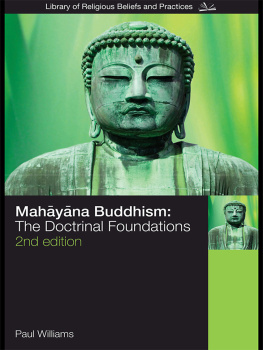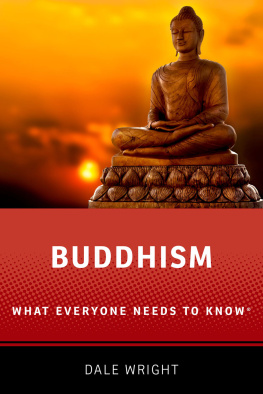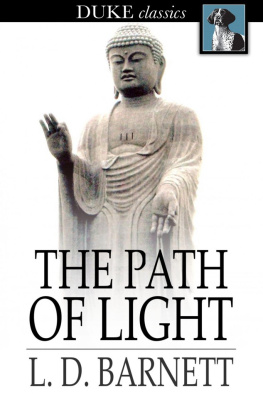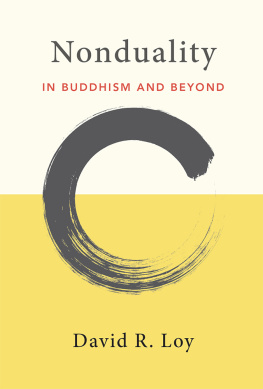
To all my dear colleagues past and present at the University of Bristols Department of Theology and Religious Studies
Mahyna Buddhism
The publication of Paul Williams Mahyna Buddhism: The Doctrinal Foundations in 1989 was a milestone in the development of Buddhist Studies, being the first truly comprehensive and authoritative attempt to chart the doctrinal landscape of Mahyna Buddhism in its entirety. Previous scholars like Edward Conze and Etienne Lamotte had set themselves this daunting task, but it had proved beyond them. Williams not only succeeded in finishing the job, but did it so well that his book has remained the primary work on the subject, and the textbook of choice for teachers of university courses on Buddhism, for 20 years. It is still unrivalled. This makes a second edition all the more welcome. Williams has extensively revised and updated the book in the light of the considerable scholarship published in this area since 1989, at the same time enlarging many of his thoughtful discussions of Mahyna Buddhist philosophical issues. The result is a tour de force of breadth and depth combined. I confidently expect that Williams richly detailed map of this field will remain for decades to come an indispensable guide to all those who venture into it.
Paul Harrison, George Edwin Burnell Professor of Religious Studies, Stanford University
Originating in India, Mahyna Buddhism spread across Asia, becoming the prevalent form of Buddhism in Tibet and East Asia. Over the last twenty-five years Western interest in Mahyna has increased considerably, reflected both in the quantity of scholarly material produced and in the attraction of Westerners towards Tibetan Buddhism and Zen.
Paul Williams Mahyna Buddhism is widely regarded as the standard introduction to the field, used internationally for teaching and research, and has been translated into several European and Asian languages. This new edition has been fully revised throughout in the light of the wealth of new studies and focuses on the religions diversity and richness. It includes much more material on China and Japan, with appropriate reference to Nepal, and for students who wish to carry their study further there is a much-expanded bibliography and extensive notes and cross-referencing. Everyone studying this important tradition will find Williams book the ideal companion to their studies.
Paul Williams is Professor of Indian and Tibetan Philosophy and Co-director of the Centre for Buddhist Studies at the University of Bristol. The author of six books and an editor of a further eight, he is a former President of the UK Association for Buddhist Studies. Among his other books for Routledge is Buddhist Thought: A Complete Introduction to the Indian Tradition (2000).
Mahyna Buddhism
The doctrinal foundations
Second edition
Paul Williams

First published 1989
by Routledge
2 Park Square, Milton Park, Abingdon, Oxon OX14 4RN
Simultaneously published in the USA and Canada
by Routledge
270 Madison Ave, New York, NY 10016
Second edition published 2009
Routledge is an imprint of the Taylor & Francis Group, an informa business
This edition published in the Taylor & Francis e-Library, 2008.
To purchase your own copy of this or any of Taylor & Francis or Routledges collection of thousands of eBooks please go to www.eBookstore.tandf.co.uk.
1989 and 2009 Paul Williams
All rights reserved. No part of this book may be reprinted or reproduced or utilised in any form or by any electronic, mechanical, or other means, now known or hereafter invented, including photocopying and recording, or in any information storage or retrieval system, without permission in writing from the publishers.
British Library Cataloguing in Publication Data
A catalogue record for this book is available from the British Library
Library of Congress Cataloging in Publication Data
Williams, Paul
Mahyna Buddhism : the doctrinal foundations / Paul Williams. 2nd ed.
p. cm. (The library of religious beliefs and practices)
Includes bibliographical references and index.
1. Mahyna BuddhismDoctrines. I. Title.
BQ7405.W55 2008
294.392dc22
2008002619
ISBN 0-203-42847-1 Master e-book ISBN
ISBN10: 0-415-35652-0 (hbk)
ISBN10: 0-415-35653-9 (pbk)
ISBN10: 0-203-42847-1 (ebk)
ISBN13: 978-0-415-35652-7 (hbk)
ISBN13: 978-0-415-35653-4 (pbk)
ISBN13: 978-0-203-42847-4 (ebk)
To all my dear colleagues past and present at the University of Bristols Department of Theology and Religious Studies
Contents
This book is intended as an introduction to the ideas of Mahyna Buddhism, and also to some of the recent scholarly work in the field. It is not an elementary academic introduction to Buddhism as a whole or to Buddhist thought. For Buddhism in general I recommend my colleague Rupert Gethins The Foundations of Buddhism (OUP, 1998). For Buddhist thought I recommend my other book (written with Anthony Tribe), Buddhist Thought: A Complete Introduction to the Indian Tradition (Routledge, 2000). Although the present volume gives the necessary background to Mahyna Buddhism, it presupposes that the reader already has an idea who the Buddha was, and what his basic teachings were.
The first edition of this book appeared in 1989. It was completed, of course, earlier. Reviewers were kind to the book. It has been widely used as the standard single volume on its subject, and translated into several languages. Since 1989, however, there has been a great deal of further research and although the book has been reprinted just about every year since its publication its original purpose as an introduction to recent scholarly work has become a little difficult to defend. Although it is recognizably the same book, organized according to the same structure as originally, in this second edition every sentence has been considered anew and rephrased or replaced where it was felt necessary. There are several new sections, and the book is significantly longer than its earlier incarnation. Compared with the first edition readers will notice there is much more consideration of East Asian Buddhism, and the practice of Mahyna. Nepalese Buddhism is mentioned where relevant. There are also many long footnotes, adding more detail, taking further the discussion of the main text, and giving guidance and references for those who wish to pursue some of the themes in greater depth and at a more advanced level. It is hoped that the book will thus serve both as a reasonably comprehensive introduction to its subject and also as a reference manual for more advanced students who wish to take their studies further.
A number of interesting areas have still had to be omitted, or receive relatively cursory treatment. Most notable in this respect, to my mind, is tantric Buddhism and Zen (Chan). Tantric Buddhism is complex and obscure, and sufficiently different in origins and sometimes perhaps tenet from other aspects of Mahyna Buddhism to require separate treatment. There is now an excellent introduction to the doctrinal aspects of Indian tantric Buddhism written by Anthony Tribe in books on Zen. I have given, I believe, the doctrinal basis necessary for understanding Zen as a particular expression of Buddhism. In the last analysis I must bow to restrictions of space.
Those familiar with the first edition of this book will notice that for this second edition Chinese names and words have been romanized in the pinyin system, although I have also given the older WadeGiles romanization of Chinese words at their first occurrence. Please also note that as far as possible all modern Japanese names are cited in the Western fashion, with the family name last. Traditionally in Japan the family name comes first, and you may sometimes find it cited that way in other publications.
Next page




















